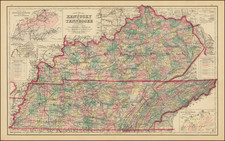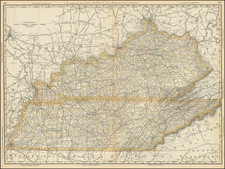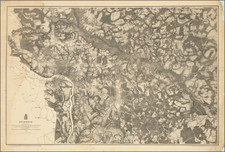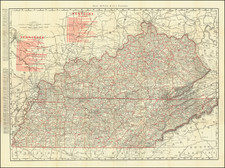Reconnaissance Map of The Rebel Positions Around Chattanooga October - November 1863
Crudely drawn reconnaissance map of the area around Chattanooga, almost certainly drawn simply constructed reconnaissance map by a Union Soldier or sympathizer during the Chattanooga Campaign of the fall of 1863. A handwritten note on the back of the map states "I give you on the inside of this a good description of Chattanooga and its fortifications."
While it is possible that the map was intended to accompany a letter home from a soldier, the broad detail of the theater and simple but precise details given are far more suggestive of a reconnaissance map. For example, the map labels the direction in which the Tennessee River is flowing and specifically references the two pontoon bridges across the river. The crossing of the river by the Union Army was a critical element of the Union Army's strategic maneuvers.
Oriented with east at the top (and the mountains at the bottom), the map shows Chattanooga at the center. To the south of the city, the Tennessee River is shown being crossed by two "Ponton Bridges", with the direction of the river shown flowing from left to right (south). A railroad line is shown coming from Bridgeport at the right, with a road coming into town from the area marked Battle Field at the top left of the map.
Several bluffs are noted along the Tennessee River, along with an area noted as "fort bluff", likely a fortified hill up river from the town. To the east of town, three rebel defense lines are shown, 2 picket lines and a main line three miles long & 6 lines deep."
The strategically important Missionary Ridge is labeled, the site of Major General William Tecumseh Sherman's surprise attack on General Braxton Bragg's right flank.
The Chattanooga Campaign
The Chattanooga campaign was a series of maneuvers and battles in October and November 1863, during the American Civil War. Following the defeat of Major General William S. Rosecrans's Union Army of the Cumberland at the Battle of Chickamauga in September, 1863 the Confederate Army of Tennessee under General Braxton Bragg besieged Rosecrans and his men by occupying key high terrain around Chattanooga, Tennessee. Major General Ulysses S. Grant was given command of Union forces in the West, now consolidated under the Division of the Mississippi. Significant reinforcements also began to arrive with him in Chattanooga from Mississippi and the Eastern Theater. On October 18, Grant removed Rosecrans from command of the Army of the Cumberland and replaced him with Major General George Henry Thomas.
Grant ordered Union engineers to construct a pontoon bridge west of town, giving the army access to shipments of food and ammunitions once again. After the opening of a supply line (the "Cracker Line") to feed the starving men and animals in Chattanooga, a force under Major General Joseph Hooker fought off a Confederate counterattack at the Battle of Wauhatchie on October 28–29, 1863.
General William Tecumseh Sherman marched his 17,000 troops from Bridgeport, Alabama, crossed the Tennessee River at Brown's Ferry, and moved into hidden camps behind the hills north of Chattanooga. He then had to re-cross the Tennessee River and attack the northern end of Missionary Ridge. This complex logistical operation required coordination, secrecy, and the silent construction of a pontoon bridge. Major Henry S. Dean's 22nd Michigan Infantry carried two pontoon bridges from downtown Chattanooga to the crossing point north of the city.
On November 23, the Army of the Cumberland advanced from the fortifications around Chattanooga to seize the strategic high ground at Orchard Knob while elements of the Union Army of the Tennessee under Major General William Tecumseh Sherman maneuvered to launch a surprise attack against Bragg's right flank on Missionary Ridge. On November 24, Sherman's men crossed the Tennessee River in the morning and then advanced to occupy high ground at the northern end of Missionary Ridge in the afternoon. The same day, a mixed force of almost three divisions under Major General Joseph Hooker defeated the Confederates in the Battle of Lookout Mountain. The next day they began a movement toward Bragg's left flank at Rossville.
On November 25, Sherman's attack on Bragg's right flank made little progress. Hoping to distract Bragg's attention, Grant ordered Thomas's army to advance in the center and take the Confederate positions at the base of Missionary Ridge. The untenability of these newly captured entrenchments caused Thomas's men to surge to the top of Missionary Ridge, routing the Army of Tennessee, which retreated to Dalton, Georgia, successfully fighting off the Union pursuit at the Battle of Ringgold Gap. Bragg's defeat eliminated the last significant Confederate control of Tennessee and opened the door to an invasion of the Deep South, leading to Sherman's Atlanta campaign of 1864.
















